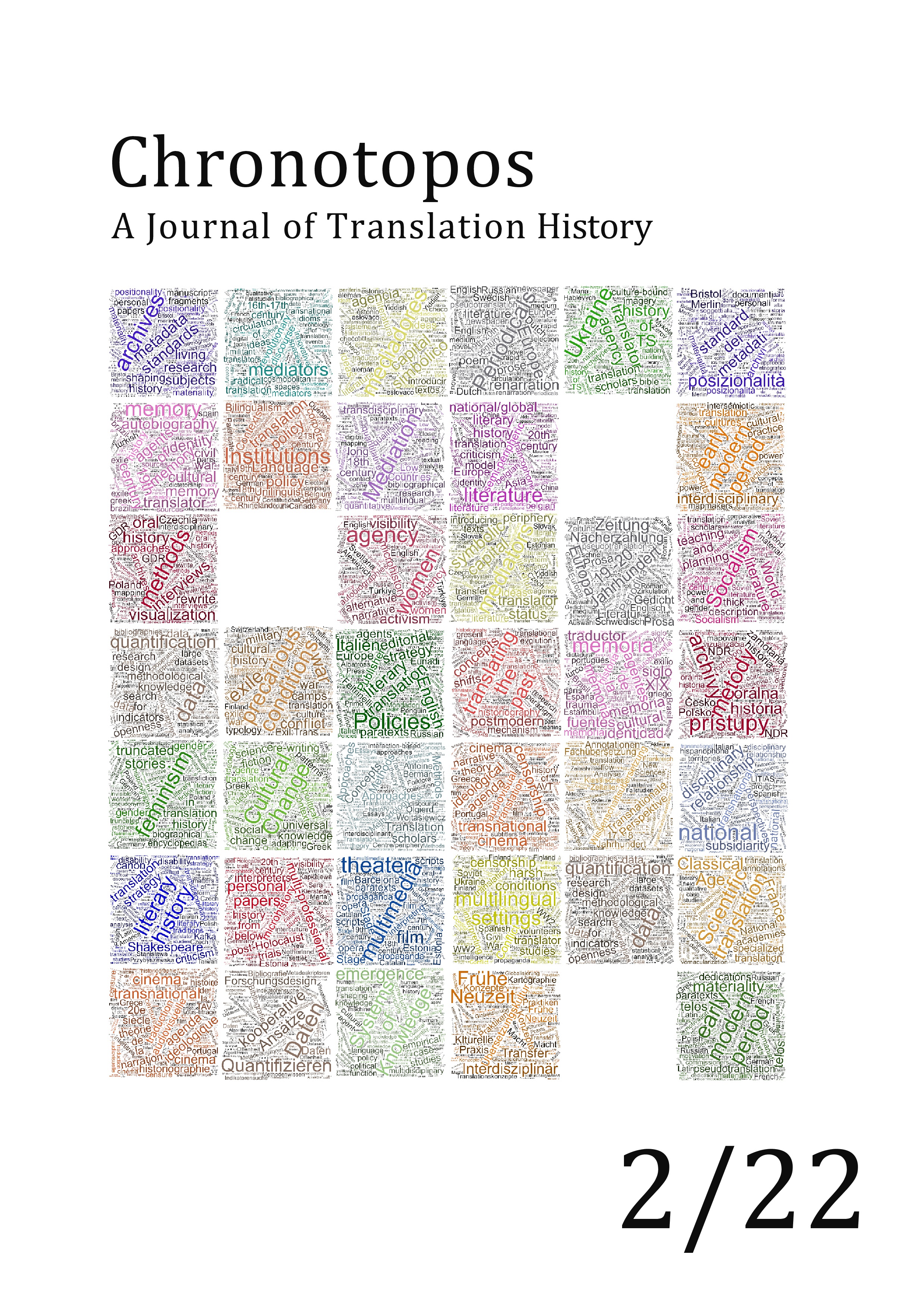Literary Translations in the Book Production of Estonian Exile Publishers
DOI:
https://doi.org/10.25365/cts-2022-4-2-5Keywords:
Estonia, fiction, exile, publishingAbstract
The article treats the activities of Estonian exile publishers in the Soviet Union (1918–1937) and in the West (1944–1991), concentrating on the publications of translated literary works. The analysis includes the study of the motives for publishing literary translations and the functions these publications were supposed to fulfil in these two different contexts of production and reception. The publishing of Estonian-language literary works in the Soviet Union is studied in the framework of national and cultural policies of the 1920s and 1930s, which determined the development of minority publishing. The output of translated literature by Estonian-language publishers is compared with the all-union translation policy and its preferences in the selection of authors for translation. The treatment of the Estonian-language publishing in the West focuses on the activities of Andres Laur and his publishing house Orto that issued most of the literary translations. The translation publications by other publishers (Vaba Eesti, Eesti Kirjanike Kooperatiiv) represent alternative modes of selection, illustrating the variety of motives.
References
AGARMAA, Ülle (1967): Eestikeelse raamatu väljaandmine NSV Liidus 1922–1934. aastal. Eesti Kirjastuse Ühisus ja kirjastus “Külvaja”. Unpublished Diploma work. Tallinn: Tallinna Pedagoogiline Instituut.
ANTIK, Richard (1939): “Eestikeelne raamat Nõukogude Venes”, Eesti Kirjandus 4, 166–177; 5, 226–235; 6, 266–275.
BLITSTEIN, Peter A. (2006): “Nation and Empire in Soviet History, 1917–1953”, Ab Imperio 1, 197–219.
FELCHER, Anastasia (2012): “Public festivities and the making of a national poet: a case study of Alexander Pushkin's biography in 1899 and 1937”, European Review of History: Revue europeenne d'histoire, 19(5), 767–788. DOI: 10.1080/13507486.2012.719013.
HEILBRON, Johan & SAPIRO, Giséle (2007): “Outline for a sociology of translation: Current issues and future prospects”. In: WOLF, M. & FUKARI, A. (eds.): Constructing a Sociology of Translation. Amsterdam: John Benjamins, 93–107.
KALAJÄRV, Jane (2012): “Kanada pagulaseestlaste kodud kultuuriidentiteedi väljendajatena”, Mäetagused 50, 29–46. DOI: 10.7592/MT2012.50.kalajarv.
KELDER, Vallo (2000): “Orto Soome-side kirjastaja ja tõlkija kirjades”. In: TEDER, E. (ed.): Eesti bibliofiilia ja raamatuajaloo almanahh. Tallinn: Tallinna Bibliofiilide Klubi,141–154.
KHESTANOV, Rouslan (2014): “The role of culture in early Soviet models of governance”, Studies in East European Thought 66 (1/2), 123–138. DOI 10.1007/s11212-014-9206-1.
KRONBERG, Janika (2002): Tiibhobu märgi all: Eesti Kirjanike Kooperatiiv 1950–1994. Tallinn: Underi ja Tuglase Kirjanduskeskus.
KRUHSE, Pauli & UITTO, Antero (2008): Suomea rajan takana 1918–1944: Suomenkielisen neuvostokirjallisuuden historia ja bibliografia. Helsinki: BTJ Finland oy, Suomen Kansalliskirjasto.
KUDDO, Arvo & LAAS, Kaljo (2002): “Rahvastik”. In: Eesti Entsüklopeedia. Vol. 11. Tallinn: Eesti Entsüklopeedikirjastus, 244–265.
KUMER-HAUKANÕMM, Kaja (2014): “1944. aasta suur põgenemine ja eliidi lahkumine Eestist”, Tuna 4, 50–56.
LANGE, Anne (2004): Ants Oras. Tartu: Ilmamaa.
LARUELLE, Marlene (2021): “The longue durée of national storytelling: Soviet roots and the quest for ethnogenesis”. In: LARUELLE, Marlene: Central Peripheries: Nationhood in Central Asia. London: UCL Press, 17-35. DOI: 10.2307/j.ctv1gn3t79.6.
“Latvians Abroad” (2016), National History Museum of Latvia, http://lnvm.lv/en/?p=1425 (20.11.2023).
MARTIN, Terry (2001): The Affirmative Action Empire: Nations and Nationalism in the Soviet Union, 1923–1939. Ithaca/London: Cornell University Press.
MONTICELLI, Daniele & LANGE, Anne (2014): “Translation and totalitarianism: the case of Soviet Estonia”, The Translator 20 (1), 95–111. DOI: 10.1080/13556509.2014.899096.
MÖLDRE, Aile & REIMO, Tiiu (2008): “Publishing Activities of Estonians in St. Petersburg before the Second World War (1918–1937)”, Knygotyra 50, 114–131.
NIINOJA, Vello (1984): “Kominterni Eesti sektsiooni kirjastustegevusest Nõukogude Liidus”, Eesti Kommunist 6, 56–58.
NÕMM, Toe (1992): “Eesti Teises maailmasõjas”. In: Eesti ajalugu ärkamisajast kuni tänapäevani. Tallinn: Koolibri, 219–234.
PEEGEL, Mari (2010): “Piret Saluri: “Sinuhes” köidab mind elu ise”, Eesti Päevaleht, January 15. https://epl.delfi.ee/artikkel/51186102/piret-saluri-sinuhes-koidab-mind-elu-ise (12.11.2023).
PÖÖGELMANN, Hans (1933): Kirjanduslikult rindelt. Leningrad: Külvaja.
https://www.digar.ee/arhiiv/nlib-digar:345917
RAUDSEPP, Anu & HIIEMAA, Karin (2013): “Vaenlase kuvandi loomine 1920–1930. aastate NSV Liidu eestikeelses õppekirjanduses”, Tuna 2, 84–95.
REBANE, Hilve (1996): “Tõlkekirjandus”. In: KRUUSPERE, P. & VIIRES, P. (eds). Eesti pagulaskirjandus 1944–1992. Tallinn: Underi ja Tuglase Kirjanduskeskus.
REBANE, Hilve (2008): “Tõlkekirjandus”. In: KRUUSPERE, P. (ed.): Eesti kirjandus paguluses XX sajandil. Tallinn: Eesti TA Underi ja Tuglase Kirjanduskeskus, 555–600.
ROBERT, Kyra (1975): “Eestikeelne trükisõna Nõukogude Liidus 1918–1940: Raamatuajalooline ülevaade”, Keel ja Kirjandus 4, 208–217; 6, 332–343.
RUDNYTSKA, Nataliia (2022): “Translation and the Formation of the Soviet Canon of World Literature”. In: RUNDLE, C.; LANGE, A. & MONTICELLI, D. (eds.): Translation Under Communism. Cham: Palgrave Macmillan, 39–71. DOI:10.1007/978-3-030-79664-8.
SHNEER, David (2003): “Who Owns the Means of Cultural Production? The Soviet Yiddish Publishing Industry of the 1920s”, Book History 6, 197–226. DOI: 10.1353/BH.2004.0012.
SUMBERG, Liina (2006): Goethes “Faust” in estnischer Übersetzung. Unpublished Master’s Thesis. Tartu: Universität Tartu.
https://dspace.ut.ee/items/2a6a9d10-e850-4677-a702-598623678dc4.
TAMMARU, Tiit; KUMER-HAUKANÕMM, Kaja & ANNISTE, Kristi (2010): “The Formation and Development of the Estonian Diaspora”, Journal of Ethnic and Migration Studies 36 (7), 1157–1174. DOI: 10.1080/1369183X.2010.481614.
“Töörahva näitekirjandus” (1924), Edasi, December 7.
URGART, Oskar (1934): “Eesti kirjandus SSSR-is”, Looming 4, 300–308.
VAIK, Kristin (2014): “Some Observations about Estonian Literary Histories Published in Exile”, Roczniki Humanistyczne 62 (1), 69–83.
VALMAS, Anne (1993): “Edukas ja kõmuline ‘Orto’”, Keel ja Kirjandus 9, 549–560.
VALMAS, Anne (2003a): Eestlaste kirjastustegevus välismaal 1944–2000. I osa. Tallinn: Tallinna Pedagoogikaülikooli Kirjastus.
VALMAS, Anne (2003b): Eestlaste kirjastustegevus välismaal 1944–2000. II osa. Raamatukataloog. Tallinn: Tallinna Pedagoogikaülikooli Kirjastus.
ZANDERS, Viesturs (2020): “Cittautu literatūras tulkojumi trimdā 20. gs. 40.–50. gados”, Letonica, 42, 20–37, https://dom.lndb.lv/data/obj/1014484.html.
ZANDERS, Viesturs (2021): “Island of Latvian Culture in Denmark : Publishing House Imanta (1946–1971)”. In: Ties Through Time : Denmark-Latvia. Riga: Danish Cultural Institute in Estonia, Latvia and Lithuania, Embassy of Denmark, 28–31. https://letland.um.dk/-/media/country-sites/letland-da/om-letland/100-gadi-eng.ashx.
БАБЕРОВСКИ, Йорг (2006): “Сталинизм и нация: Советский Союз как многонацио¬нальное государство, 1917–1953”, Ab Imperio 1, 177–196. DOI: 10.1353/imp.2006.0037.
МУСАЕВ, В. И. (2009): Эстонская диаспора на Северо-Западе России во второй половине XX в. Санкт Петербург: Нестор.
Downloads
Published
How to Cite
Issue
Section
License
Copyright (c) 2024 Aile Möldre

This work is licensed under a Creative Commons Attribution-NonCommercial 4.0 International License.

licence: CC BY-NC 4.0


